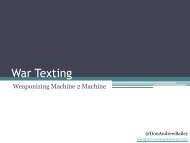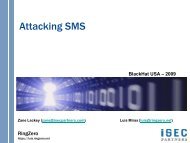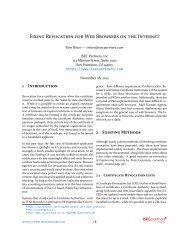an introduction to authenticated encryption - iSEC Partners
an introduction to authenticated encryption - iSEC Partners
an introduction to authenticated encryption - iSEC Partners
You also want an ePaper? Increase the reach of your titles
YUMPU automatically turns print PDFs into web optimized ePapers that Google loves.
• Integrity of plaintext (INT-PTXT) is the requirement that it is computationally infeasible for <strong>an</strong> attacker <strong>to</strong><br />
create a valid ciphertext for a corresponding message.<br />
• Integrity of ciphertext (INT-CTXT) is the requirement that it is computationally infeasible for <strong>an</strong> attacker <strong>to</strong><br />
create a valid ciphertext, regardless of whether this ciphertext corresponds <strong>to</strong> a message.<br />
Any system that is INT-CTXT is also INT-PTXT; Additionally if a system has IND-CPA <strong>an</strong>d INT-CTXT it is also<br />
IND-CCA secure.<br />
This <strong>an</strong>alysis by Bellare <strong>an</strong>d Namprempre prompted a number of studies of existing security pro<strong>to</strong>cols such as [3, 4]<br />
where it was demonstrated that even though SSL uses MtE, it is IND-CCA. This security however is tenuous <strong>an</strong>d<br />
seemingly innocuous ch<strong>an</strong>ges such as encrypting the message <strong>an</strong>d MAC separately using different initialisation<br />
vec<strong>to</strong>rs or using variable length padding <strong>an</strong>d truncated MACs (as specified in TLS 1.2) c<strong>an</strong> break the security of the<br />
system. 2 Schemes c<strong>an</strong> also be constructed using E&M that are not IND-CPA secure, a simple example being <strong>to</strong> use a<br />
MAC that provides message integrity but that leaks part of the underlying message; such a MAC would be perfectly<br />
acceptable on its own, but results in a trivial break when combined with <strong>encryption</strong>. It was clear from this that<br />
a more formal approach <strong>to</strong> the construction of <strong>encryption</strong> <strong>an</strong>d authentication schemes needed <strong>to</strong> be devised <strong>an</strong>d<br />
st<strong>an</strong>dardized.<br />
Authenticated Encryption combines message authentication <strong>an</strong>d message integrity in<strong>to</strong> one mode such that the<br />
end result is IND-CPA + INT-CTXT <strong>an</strong>d therefore IND-CCA <strong>an</strong>d INT-PTXT as well. It removes the need for developers<br />
<strong>an</strong>d system designers <strong>to</strong> create their own, potentially insecure constructs by providing them one operation <strong>to</strong><br />
meet these requirements. Additionally, by essentially providing one more layer of abstraction, it promotes cryp<strong>to</strong>graphic<br />
agility, 3 which is the design of a system such that the underlying algorithms c<strong>an</strong> be ch<strong>an</strong>ged without large<br />
re-designs of the existing system. Traditional schemes that used separate MAC <strong>an</strong>d <strong>encryption</strong> algorithms required<br />
independent keys <strong>to</strong> be used <strong>an</strong>d securely m<strong>an</strong>aged, something that does not always happen. All the <strong>authenticated</strong><br />
<strong>encryption</strong> modes discussed here use one key in a m<strong>an</strong>ner that does not compromise security.<br />
2 AUTHENTICATED ENCRYPTION MODES<br />
The following is a brief overview of the most popular <strong>authenticated</strong> <strong>encryption</strong> (AE) modes that have been developed<br />
as a result of the research discussed in the previous section. The aim is <strong>to</strong> provide enough detail <strong>to</strong> allow the reader<br />
<strong>to</strong> underst<strong>an</strong>d the potential pros <strong>an</strong>d cons of each mode.<br />
Before discussing individual modes, it is useful <strong>to</strong> underst<strong>an</strong>d a few key properties of <strong>authenticated</strong> <strong>encryption</strong><br />
modes (although not all modes discussed here exhibit these properties). A useful property of <strong>an</strong> AE mode is <strong>to</strong><br />
support both data that is <strong>to</strong> be encrypted <strong>an</strong>d <strong>authenticated</strong> <strong>an</strong>d data that is not encrypted but that needs <strong>to</strong> be<br />
<strong>authenticated</strong>; this concept is referred <strong>to</strong> as <strong>authenticated</strong> <strong>encryption</strong> with associated data (AEAD). 4 A conceptual<br />
example of this is a network packet that contains a payload <strong>an</strong>d routing information; it would be useful <strong>to</strong> encrypt <strong>an</strong>d<br />
authenticate the payload while allowing the routing information <strong>to</strong> be in plaintext, while still being <strong>authenticated</strong><br />
<strong>an</strong>d cryp<strong>to</strong>graphically bound <strong>to</strong> the payload. Another concept of AE is that of being on-line. On-line me<strong>an</strong>s that<br />
the length of the message <strong>an</strong>d <strong>an</strong>y associated data are not required <strong>to</strong> be known before <strong>encryption</strong> is performed;<br />
this property c<strong>an</strong> be beneficial in streaming <strong>an</strong>d other environments where the size of the encrypted message is<br />
tr<strong>an</strong>sparent <strong>to</strong> the algorithm. There are other import<strong>an</strong>t concepts such as parallelization <strong>an</strong>d whether the mode is<br />
one or two pass, but these will be discussed in the relev<strong>an</strong>t sections.<br />
All AE modes discussed in this paper share the same underlying <strong>encryption</strong> mode called counter mode (CTR).<br />
Counter mode takes as input a message M, a key K <strong>an</strong>d a nonce N. The message is broken in<strong>to</strong> m blocks where<br />
m is the block length of the underlying algorithm. A counter value is created from the nonce such that there are<br />
2 It should be noted that these <strong>an</strong>alysis generally do not model attacks that exploit the ability <strong>to</strong> differentiate the cause of decryption failures<br />
such as padding failures or authentication failures or attacks involving chained IVs in CBC.<br />
3 To be clear, only some <strong>authenticated</strong> <strong>encryption</strong> modes allow <strong>an</strong>y secure underlying algorithm <strong>to</strong> be used<br />
4 For simplicity's sake, none of the diagrams presented in this document reference associated data.<br />
HTTPS://WWW.ISECPARTNERS.COM 2/10







